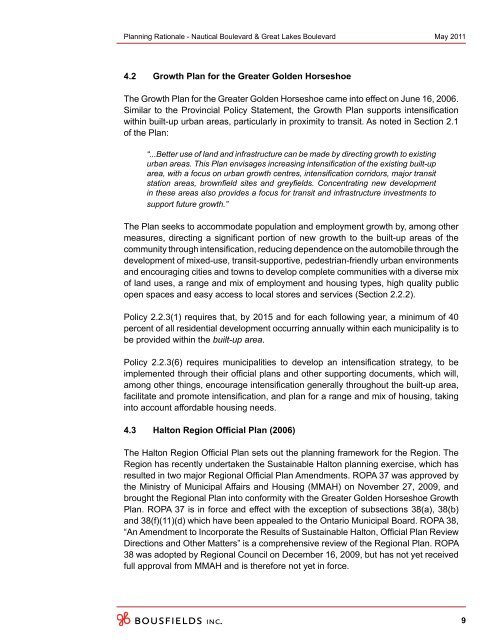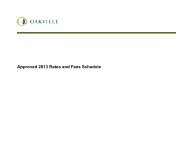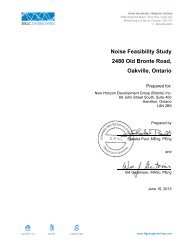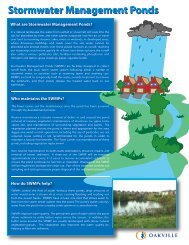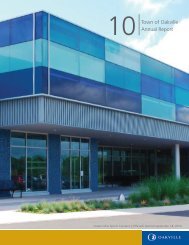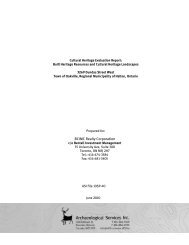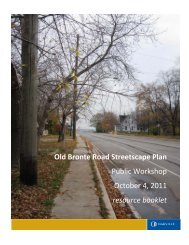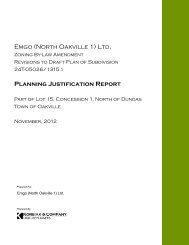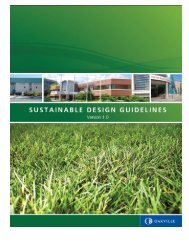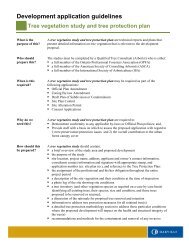PLANNING RATIONALE - Oakville
PLANNING RATIONALE - Oakville
PLANNING RATIONALE - Oakville
Create successful ePaper yourself
Turn your PDF publications into a flip-book with our unique Google optimized e-Paper software.
Planning Rationale - Nautical Boulevard & Great Lakes Boulevard<br />
May 2011<br />
4.2 Growth Plan for the Greater Golden Horseshoe<br />
The Growth Plan for the Greater Golden Horseshoe came into effect on June 16, 2006.<br />
Similar to the Provincial Policy Statement, the Growth Plan supports intensification<br />
within built-up urban areas, particularly in proximity to transit. As noted in Section 2.1<br />
of the Plan:<br />
“...Better use of land and infrastructure can be made by directing growth to existing<br />
urban areas. This Plan envisages increasing intensification of the existing built-up<br />
area, with a focus on urban growth centres, intensification corridors, major transit<br />
station areas, brownfield sites and greyfields. Concentrating new development<br />
in these areas also provides a focus for transit and infrastructure investments to<br />
support future growth.”<br />
The Plan seeks to accommodate population and employment growth by, among other<br />
measures, directing a significant portion of new growth to the built-up areas of the<br />
community through intensification, reducing dependence on the automobile through the<br />
development of mixed-use, transit-supportive, pedestrian-friendly urban environments<br />
and encouraging cities and towns to develop complete communities with a diverse mix<br />
of land uses, a range and mix of employment and housing types, high quality public<br />
open spaces and easy access to local stores and services (Section 2.2.2).<br />
Policy 2.2.3(1) requires that, by 2015 and for each following year, a minimum of 40<br />
percent of all residential development occurring annually within each municipality is to<br />
be provided within the built-up area.<br />
Policy 2.2.3(6) requires municipalities to develop an intensification strategy, to be<br />
implemented through their official plans and other supporting documents, which will,<br />
among other things, encourage intensification generally throughout the built-up area,<br />
facilitate and promote intensification, and plan for a range and mix of housing, taking<br />
into account affordable housing needs.<br />
4.3 Halton Region Official Plan (2006)<br />
The Halton Region Official Plan sets out the planning framework for the Region. The<br />
Region has recently undertaken the Sustainable Halton planning exercise, which has<br />
resulted in two major Regional Official Plan Amendments. ROPA 37 was approved by<br />
the Ministry of Municipal Affairs and Housing (MMAH) on November 27, 2009, and<br />
brought the Regional Plan into conformity with the Greater Golden Horseshoe Growth<br />
Plan. ROPA 37 is in force and effect with the exception of subsections 38(a), 38(b)<br />
and 38(f)(11)(d) which have been appealed to the Ontario Municipal Board. ROPA 38,<br />
“An Amendment to Incorporate the Results of Sustainable Halton, Official Plan Review<br />
Directions and Other Matters” is a comprehensive review of the Regional Plan. ROPA<br />
38 was adopted by Regional Council on December 16, 2009, but has not yet received<br />
full approval from MMAH and is therefore not yet in force.<br />
9


